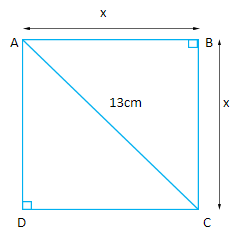
If diagonal of a square is 13cm, then find its side.
Answer
570.3k+ views
Hint:
We will use the Pythagoras theorem in the right triangle formed by the sides and diagonal of the square as: ${\text{hypotenus}}{{\text{e}}^2}{\text{ = perpendicula}}{{\text{r}}^2}{\text{ + bas}}{{\text{e}}^2}$ since all angles (vertex) of a square are of ${90^ \circ }$.
Complete step by step solution:
We need to find the length of the side of the square.

Since all sides of the square are equal, let the sides be of length x cm each. And AC be the diagonal of the square whose length is 13cm.
We know that all the corner angles of a square are of ${90^ \circ }$, therefore, we can use Pythagoras theorem given by: ${\text{hypotenus}}{{\text{e}}^2}{\text{ = perpendicular}}{{\text{r}}^2}{\text{ + bas}}{{\text{e}}^2}$
Using Pythagoras theorem in $\vartriangle ABC$, we get
$
\Rightarrow {\text{hypotenus}}{{\text{e}}^2}{\text{ = perpendicula}}{{\text{r}}^2}{\text{ + bas}}{{\text{e}}^2} \\
\Rightarrow {\left( {AC} \right)^2} = {\left( {AB} \right)^2} + {\left( {BC} \right)^2} \\
$
Substituting the values of AC, AB and BC, we get
$
\Rightarrow {\left( {13} \right)^2} = {\left( x \right)^2} + {\left( x \right)^2} \\
\Rightarrow 169 = 2{x^2} \\
\Rightarrow {x^2} = \dfrac{{169}}{2} \\
\Rightarrow x = \sqrt {\dfrac{{169}}{2}} = \dfrac{{13}}{{\sqrt 2 }} = \dfrac{{6.5 \times 2}}{{\sqrt 2 }} = 6.5\sqrt 2 {\text{cm}} \\
$
Therefore, the side of the square is of length $6.5\sqrt 2 {\text{cm}}$.
Note:
In this question, you can get confused in the calculation of x from the equation obtained after using the Pythagoras theorem. You can calculate it directly by taking the square root of $\dfrac{{169}}{2} = 84.5$for the value of x instead of converting it into the form of $6.5\sqrt 2 $. You can also solve this question by directly applying the formula of relation between the diagonal of the square and its sides given as: Diagonal = $\sqrt 2 a$ , where a is the length of the side of the square, instead of using the Pythagoras theorem. This method will be helpful in MCQs to conserve time and get solutions quickly.
We will use the Pythagoras theorem in the right triangle formed by the sides and diagonal of the square as: ${\text{hypotenus}}{{\text{e}}^2}{\text{ = perpendicula}}{{\text{r}}^2}{\text{ + bas}}{{\text{e}}^2}$ since all angles (vertex) of a square are of ${90^ \circ }$.
Complete step by step solution:
We need to find the length of the side of the square.

Since all sides of the square are equal, let the sides be of length x cm each. And AC be the diagonal of the square whose length is 13cm.
We know that all the corner angles of a square are of ${90^ \circ }$, therefore, we can use Pythagoras theorem given by: ${\text{hypotenus}}{{\text{e}}^2}{\text{ = perpendicular}}{{\text{r}}^2}{\text{ + bas}}{{\text{e}}^2}$
Using Pythagoras theorem in $\vartriangle ABC$, we get
$
\Rightarrow {\text{hypotenus}}{{\text{e}}^2}{\text{ = perpendicula}}{{\text{r}}^2}{\text{ + bas}}{{\text{e}}^2} \\
\Rightarrow {\left( {AC} \right)^2} = {\left( {AB} \right)^2} + {\left( {BC} \right)^2} \\
$
Substituting the values of AC, AB and BC, we get
$
\Rightarrow {\left( {13} \right)^2} = {\left( x \right)^2} + {\left( x \right)^2} \\
\Rightarrow 169 = 2{x^2} \\
\Rightarrow {x^2} = \dfrac{{169}}{2} \\
\Rightarrow x = \sqrt {\dfrac{{169}}{2}} = \dfrac{{13}}{{\sqrt 2 }} = \dfrac{{6.5 \times 2}}{{\sqrt 2 }} = 6.5\sqrt 2 {\text{cm}} \\
$
Therefore, the side of the square is of length $6.5\sqrt 2 {\text{cm}}$.
Note:
In this question, you can get confused in the calculation of x from the equation obtained after using the Pythagoras theorem. You can calculate it directly by taking the square root of $\dfrac{{169}}{2} = 84.5$for the value of x instead of converting it into the form of $6.5\sqrt 2 $. You can also solve this question by directly applying the formula of relation between the diagonal of the square and its sides given as: Diagonal = $\sqrt 2 a$ , where a is the length of the side of the square, instead of using the Pythagoras theorem. This method will be helpful in MCQs to conserve time and get solutions quickly.
Recently Updated Pages
Master Class 9 Social Science: Engaging Questions & Answers for Success

Master Class 9 Science: Engaging Questions & Answers for Success

Master Class 9 English: Engaging Questions & Answers for Success

Master Class 9 Maths: Engaging Questions & Answers for Success

Master Class 9 General Knowledge: Engaging Questions & Answers for Success

Class 9 Question and Answer - Your Ultimate Solutions Guide

Trending doubts
Which places in India experience sunrise first and class 9 social science CBSE

Fill the blanks with the suitable prepositions 1 The class 9 english CBSE

Write the 6 fundamental rights of India and explain in detail

Difference Between Plant Cell and Animal Cell

What is pollution? How many types of pollution? Define it

What is the Full Form of ISI and RAW




